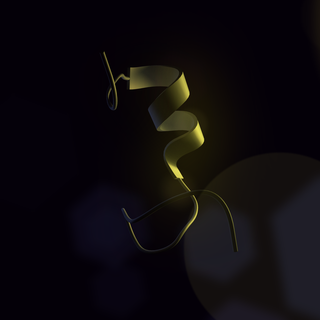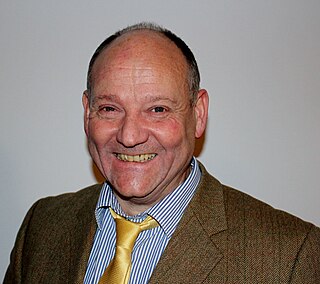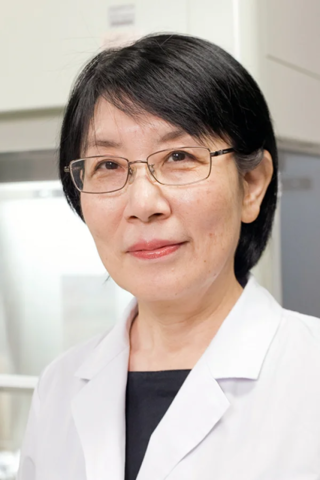Related Research Articles

Chronobiology is a field of biology that examines timing processes, including periodic (cyclic) phenomena in living organisms, such as their adaptation to solar- and lunar-related rhythms. These cycles are known as biological rhythms. Chronobiology comes from the ancient Greek χρόνος, and biology, which pertains to the study, or science, of life. The related terms chronomics and chronome have been used in some cases to describe either the molecular mechanisms involved in chronobiological phenomena or the more quantitative aspects of chronobiology, particularly where comparison of cycles between organisms is required.

The suprachiasmatic nucleus or nuclei (SCN) is a small region of the brain in the hypothalamus, situated directly above the optic chiasm. It is the principal circadian pacemaker in mammals, responsible for generating circadian rhythms. Reception of light inputs from photosensitive retinal ganglion cells allow it to coordinate the subordinate cellular clocks of the body and entrain to the environment. The neuronal and hormonal activities it generates regulate many different body functions in an approximately 24-hour cycle.
The Casein kinase 1 family of protein kinases are serine/threonine-selective enzymes that function as regulators of signal transduction pathways in most eukaryotic cell types. CK1 isoforms are involved in Wnt signaling, circadian rhythms, nucleo-cytoplasmic shuttling of transcription factors, DNA repair, and DNA transcription.
Timeless (tim) is a gene in multiple species but is most notable for its role in Drosophila for encoding TIM, an essential protein that regulates circadian rhythm. Timeless mRNA and protein oscillate rhythmically with time as part of a transcription-translation negative feedback loop involving the period (per) gene and its protein.
Period (per) is a gene located on the X chromosome of Drosophila melanogaster. Oscillations in levels of both per transcript and its corresponding protein PER have a period of approximately 24 hours and together play a central role in the molecular mechanism of the Drosophila biological clock driving circadian rhythms in eclosion and locomotor activity. Mutations in the per gene can shorten (perS), lengthen (perL), and even abolish (per0) the period of the circadian rhythm.

The PER3 gene encodes the period circadian protein homolog 3 protein in humans. PER3 is a paralog to the PER1 and PER2 genes. It is a circadian gene associated with delayed sleep phase syndrome in humans.

PER2 is a protein in mammals encoded by the PER2 gene. PER2 is noted for its major role in circadian rhythms.

Period circadian protein homolog 1 is a protein in humans that is encoded by the PER1 gene.

Jürgen Walther Ludwig Aschoff was a German physician, biologist and behavioral physiologist. Together with Erwin Bünning and Colin Pittendrigh, he is considered to be a co-founder of the field of chronobiology.
Joseph S. Takahashi is a Japanese American neurobiologist and geneticist. Takahashi is a professor at University of Texas Southwestern Medical Center as well as an investigator at the Howard Hughes Medical Institute. Takahashi's research group discovered the genetic basis for the mammalian circadian clock in 1994 and identified the Clock gene in 1997. Takahashi was elected to the National Academy of Sciences in 2003.

Russell Grant Foster, CBE, FRS FMedSci is a British professor of circadian neuroscience, the Director of the Nuffield Laboratory of Ophthalmology and the Head of the Sleep and Circadian Neuroscience Institute (SCNi). He is also a Nicholas Kurti Senior Fellow at Brasenose College at the University of Oxford. Foster and his group are credited with key contributions to the discovery of the non-rod, non-cone, photosensitive retinal ganglion cells (pRGCs) in the mammalian retina which provide input to the circadian rhythm system. He has written and co-authored over a hundred scientific publications.
Michael Menaker, was an American chronobiologist who was Commonwealth Professor of Biology at University of Virginia. His research focused on circadian rhythmicity of vertebrates, including contributing to an understanding of light input pathways on extra-retinal photoreceptors of non-mammalian vertebrates, discovering a mammalian mutation for circadian rhythmicity, and locating a circadian oscillator in the pineal gland of bird. He wrote almost 200 scientific publications.
Hitoshi Okamura is a Japanese scientist who specializes in chronobiology. He is currently a professor of Systems Biology at Kyoto University Graduate School of Pharmaceutical Sciences and the Research Director of the Japan Science Technology Institute, CREST. Okamura's research group cloned mammalian Period genes, visualized clock oscillation at the single cell level in the central clock of the SCN, and proposed a time-signal neuronal pathway to the adrenal gland. He received a Medal of Honor with Purple Ribbon in 2007 for his research and was awarded Aschoff's Ruler for his work on circadian rhythms in rodents. His lab recently revealed the effects of m6A mRNA methylation on the circadian clock, neuronal communications in jet lag, and the role of dysregulated clocks in salt-induced hypertension.
Robert Y. Moore is an American neurologist with interests in disorders of biological rhythms, movement disorders, and behavioral neurology. He is credited with discovering the function of the suprachiasmatic nucleus (SCN) as the circadian clock, as well as, describing its organization. He is also credited with establishing the role of the mammalian retinohypothalamic tract (RHT) as a photic entrainment pathway. Moore cin 2017 serves as a professor of neurology, with a secondary in psychiatry and neuroscience at the University of Pittsburgh, and as co-director of the National Parkinson Foundation Center of Excellence at the University of Pittsburgh.
In the field of chronobiology, the dual circadian oscillator model refers to a model of entrainment initially proposed by Colin Pittendrigh and Serge Daan. The dual oscillator model suggests the presence of two coupled circadian oscillators: E (evening) and M (morning). The E oscillator is responsible for entraining the organism’s evening activity to dusk cues when the daylight fades, while the M oscillator is responsible for entraining the organism’s morning activity to dawn cues, when daylight increases. The E and M oscillators operate in an antiphase relationship. As the timing of the sun's position fluctuates over the course of the year, the oscillators' periods adjust accordingly. Other oscillators, including seasonal oscillators, have been found to work in conjunction with circadian oscillators in order to time different behaviors in organisms such as fruit flies.

Sato Honma is a Japanese chronobiologist who researches the biological mechanisms of circadian rhythms. She mainly collaborates with Ken-Ichi Honma on publications, and both of their primary research focuses are the human circadian clock under temporal isolation and the mammalian suprachiasmatic nucleus (SCN), its components, and associates. Honma is a retired professor at the Hokkaido University School of Medicine in Sapporo, Japan. She received her Ph.D. in physiology from Hokkaido University. She taught physiology at the School of Medicine and then at the Research and Education Center for Brain Science at Hokkaido University. She is currently the director at the Center for Sleep and Circadian Rhythm Disorders at Sapporo Hanazono Hospital and works as a somnologist.
Johanna H. Meijer is a Dutch scientist who has contributed significantly to the field of chronobiology. Meijer has made notable contributions to the understanding of the neural and molecular mechanisms of circadian pacemakers. She is known for her extensive studies of photic and non-photic effects on the mammalian circadian clocks. Notably, Meijer is the 2016 recipient of the Aschoff and Honma Prize, one of the most prestigious international prizes in the circadian research field. In addition to still unraveling neuronal mechanisms of circadian clocks and their applications to health, Meijer's lab now studies the effects of modern lifestyles on our circadian rhythm and bodily functions.
The food-entrainable oscillator (FEO) is a circadian clock that can be entrained by varying the time of food presentation. It was discovered when a rhythm was found in rat activity. This was called food anticipatory activity (FAA), and this is when the wheel-running activity of mice decreases after feeding, and then rapidly increases in the hours leading up to feeding. FAA appears to be present in non-mammals (pigeons/fish), but research heavily focuses on its presence in mammals. This rhythmic activity does not require the suprachiasmatic nucleus (SCN), the central circadian oscillator in mammals, implying the existence of an oscillator, the FEO, outside of the SCN, but the mechanism and location of the FEO is not yet known. There is ongoing research to investigate if the FEO is the only non-light entrainable oscillator in the body.
Elizabeth Maywood is an English researcher who studies circadian rhythms and sleep in mice. Her studies are focused on the suprachiasmatic nucleus (SCN), a small region of the brain that controls circadian rhythms.
Ken-Ichi Honma is a Japanese chronobiologist who researches the biological mechanisms underlying circadian rhythms. After graduating from Hokkaido University School of Medicine, he practiced clinical psychiatry before beginning his research. His recent research efforts are centered around photic and non-photic entrainment, the structure of circadian clocks, and the ontogeny of circadian clocks. He often collaborates with his wife, Sato Honma, on work involving the mammalian suprachiasmatic nucleus (SCN).
References
- ↑ "Loop | MARTIN RALPH". loop.frontiersin.org. Retrieved 2023-04-11.
- ↑ Daan, Serge; Pittendrigh, Colin S. (1976-10-01). "A Functional analysis of circadian pacemakers in nocturnal rodents". Journal of Comparative Physiology. 106 (3): 253–266. doi:10.1007/BF01417857. ISSN 1432-1351. S2CID 7164170.
- ↑ Ralph, Martin R.; Menaker, Michael (1988-09-02). "A Mutation of the Circadian System in Golden Hamsters". Science. 241 (4870): 1225–1227. Bibcode:1988Sci...241.1225R. doi:10.1126/science.3413487. ISSN 0036-8075. PMID 3413487.
- ↑ Refinetti, Roberto (2014). "Relationship between circadian period and body size in the tau -mutant golden hamster". Canadian Journal of Physiology and Pharmacology. 92 (1): 27–33. doi:10.1139/cjpp-2013-0276. ISSN 0008-4212. PMID 24383870.
- ↑ Anne Stirland, J.; Grosse, Julia; Loudon, Andrew S.I.; Hastings, Michael H.; Maywood, Elizabeth S. (1995-08-01). "Gonadal Responses of the Male Tau Mutant Syrian Hamster to Short-Day-Like Programmed Infusions of Melatonin1". Biology of Reproduction. 53 (2): 361–367. doi: 10.1095/biolreprod53.2.361 . ISSN 0006-3363. PMID 7492688.
- ↑ Lisitsyn, Nikolai A.; Segre, Julia A.; Kusumi, Kenro; Lisitsyn, Natalia M.; Nadeau, Joseph H.; Frankel, Wayne N.; Wigler, Michael H.; Lander, Eric S. (1994). "Direct isolation of polymorphic markers linked to a trait by genetically directed representational difference analysis". Nature Genetics. 6 (1): 57–63. doi:10.1038/ng0194-57. ISSN 1061-4036. PMID 8136836. S2CID 19474123.
- ↑ Lowrey, Phillip L.; Shimomura, Kazuhiro; Antoch, Marina P.; Yamazaki, Shin; Zemenides, Peter D.; Ralph, Martin R.; Menaker, Michael; Takahashi, Joseph S. (2000-04-21). "Positional Syntenic Cloning and Functional Characterization of the Mammalian Circadian Mutation tau". Science. 288 (5465): 483–491. Bibcode:2000Sci...288..483L. doi:10.1126/science.288.5465.483. ISSN 0036-8075. PMC 3869379 . PMID 10775102.
- ↑ Ko, Caroline H.; Takahashi, Joseph S. (15 October 2006). "Molecular components of the mammalian circadian clock". Human Molecular Genetics. 15: R271–R277. doi:10.1093/hmg/ddl207. PMC 3762864 . PMID 16987893 . Retrieved 2023-04-11.
- ↑ Ralph, Martin R.; Foster, Russell G.; Davis, Fred C.; Menaker, Michael (1990-02-23). "Transplanted Suprachiasmatic Nucleus Determines Circadian Period". Science. 247 (4945): 975–978. Bibcode:1990Sci...247..975R. doi:10.1126/science.2305266. ISSN 0036-8075. PMID 2305266.
- ↑ Gall, Andrew J.; Shuboni-Mulligan, Dorela D. (2022). "Keep Your Mask On: The Benefits of Masking for Behavior and the Contributions of Aging and Disease on Dysfunctional Masking Pathways". Frontiers in Neuroscience. 16: 911153. doi: 10.3389/fnins.2022.911153 . PMC 9395722 . PMID 36017187.
- ↑ Pickard, Gary E.; Ralph, Martin R.; Menaker, Michael (March 1987). "The Intergeniculate Leaflet Partially Mediates Effects of Light on Circadian Rhythms". Journal of Biological Rhythms. 2 (1): 35–56. doi: 10.1177/074873048700200104 . ISSN 0748-7304. PMID 2979650. S2CID 26133014.
- ↑ Ralph, Martin R.; Mrosovsky, N. (December 1992). "Behavioral Inhibition of Circadian Responses to Light". Journal of Biological Rhythms. 7 (4): 353–359. doi:10.1177/074873049200700408. ISSN 0748-7304. PMID 1286206. S2CID 35179700.
- ↑ Ralph MR, Menaker M. GABA regulation of circadian responses to light. I. Involvement of GABAA-benzodiazepine and GABAB receptors. J Neurosci. 1989;9(8):2858-2865. doi:10.1523/JNEUROSCI.09-08-02858.1989
- ↑ Cain, Sean W.; Ralph, Martin R. (2009-01-01). "Circadian modulation of conditioned place avoidance in hamsters does not require the suprachiasmatic nucleus". Neurobiology of Learning and Memory. 91 (1): 81–84. doi:10.1016/j.nlm.2008.10.005. ISSN 1074-7427. PMID 19013252. S2CID 207261479.
- ↑ Cain, Sean W.; Rawashdeh, Omar A.; Siu, Michael; Kim, Seung Cheol; Ralph, Martin R. (2017-05-01). "Dopamine dependent setting of a circadian oscillator underlying the memory for time of day". Neurobiology of Learning and Memory. 141: 78–83. doi:10.1016/j.nlm.2017.03.015. ISSN 1074-7427. PMID 28366864. S2CID 4373649.
- ↑ Hurd, Mark W.; Ralph, Martin R. (October 1998). "The Significance of Circadian Organization for Longevity in the Golden Hamster". Journal of Biological Rhythms. 13 (5): 430–436. doi:10.1177/074873098129000255. ISSN 0748-7304. PMID 9783234. S2CID 7088058.
- ↑ Schweitzer, Jeffrey S.; Song, Bin; Herrington, Todd M.; Park, Tae-Yoon; Lee, Nayeon; Ko, Sanghyeok; Jeon, Jeha; Cha, Young; Kim, Kyungsang; Li, Quanzheng; Henchcliffe, Claire; Kaplitt, Michael; Neff, Carolyn; Rapalino, Otto; Seo, Hyemyung (2020-05-14). "Personalized iPSC-Derived Dopamine Progenitor Cells for Parkinson's Disease". New England Journal of Medicine. 382 (20): 1926–1932. doi:10.1056/NEJMoa1915872. ISSN 0028-4793. PMC 7288982 . PMID 32402162.
- ↑ Wang, Jiaming; Tian, Yu; Shi, Xin; Feng, Zhaohai; Jiang, Lei; Hao, Yujun (2022-05-06). "Safety and Efficacy of Cell Transplantation on Improving Motor Symptoms in Patients With Parkinson's Disease: A Meta-Analysis". Frontiers in Human Neuroscience. 16: 849069. doi: 10.3389/fnhum.2022.849069 . ISSN 1662-5161. PMC 9120834 . PMID 35601911.
- ↑ Tong, L. M.; Djukic, B.; Arnold, C.; Gillespie, A. K.; Yoon, S. Y.; Wang, M. M.; Zhang, O.; Knoferle, J.; Rubenstein, J. L. R.; Alvarez-Buylla, A.; Huang, Y. (2014-07-16). "Inhibitory Interneuron Progenitor Transplantation Restores Normal Learning and Memory in ApoE4 Knock-In Mice without or with A Accumulation". Journal of Neuroscience. 34 (29): 9506–9515. doi:10.1523/JNEUROSCI.0693-14.2014. ISSN 0270-6474. PMC 4099537 . PMID 25031394.
- 1 2 3 "Martin R. Ralph: H-index & Awards - Academic Profile". Research.com. Retrieved 2023-04-11.
- ↑ Shrestha, Tenjin C.; Šuchmanová, Karolína; Houdek, Pavel; Sumová, Alena; Ralph, Martin R. (2018-10-19). "Implicit time-place conditioning alters Per2 mRNA expression selectively in striatum without shifting its circadian clocks". Scientific Reports. 8 (1): 15547. Bibcode:2018NatSR...815547S. doi:10.1038/s41598-018-33637-y. ISSN 2045-2322. PMC 6195625 . PMID 30341352.
- ↑ "Loop | MARTIN RALPH". loop.frontiersin.org. Retrieved 2023-04-27.
- ↑ "Martin R. Ralph - EBRS". www.ebrs-online.org. Retrieved 2023-04-11.